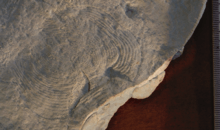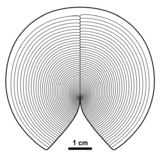Ovatoscutum
| Ovatoscutum | |
|---|---|
 | |
| Cast of Ovatoscutum concentricum | |
| Scientific classification | |
| Kingdom: | Animalia |
| Phylum: | Proarticulata |
| Genus: | Ovatoscutum Glaessner & Wade, 1966 |
| Species | |
| |
Ovatoscutum is one of many enigmatic organisms known from the Ediacaran deposits of the Flinders Ranges, Australia, and the White Sea area in Russia, dating around 555 Ma. This genus contains one species, Ovatoscutum concentricum.
Etymology
The generic name Ovatoscutum is derived from the Latin ovatus (oval) and scutum (sheld).
Description
This fossil has the form of a rounded shield, enclosing strongly concentric corrugations or ribs, which weaken adjacent to a triangular neckline. A suture-like zone extends through the center from the apex of the neckline towards the opposite margin. The ribs become wider towards the periphery.[1][2]
Affinity

Ovatoscutum was first described by Martin Glaessner and Mary Wade in 1966, and this team tentatively interpreted it as a chondrophoran pneumatophore. This notion was based on morphologies apparently shared between Ovatoscutum and the Devonian Plectodiscus, leading to an interpretation of the organism as a velellid float (pneumatophore), which itself bears a passing resemblance to the modern chondrophoran pneumatophore Velella. Thus the hypothesis emerged that the Ovatoscutum was a pelagic Hydrozoa Chondrophora. This hypothesis later became popular and was widely quoted, despite the absence of further research. [3][4][2][5][6]
As far back as 1966 Glaessner and Wade remarked that no evidence of a velellid 'sail' existed in Ovatoscutum and that Ovatoscutum differed from all Porpitidae chondrophora.[1]
Ovatoscutum fossils are negative imprints on the bases of sandstone beds with the "elephant skin" and tubercle texture, diagnostic of microbial mats. The same bedding planes contain various other benthic organisms: Yorgia, Andiva, Dickinsonia, Tribrachidium, Kimberella, Parvancorina and others.
The Ediacaran assemblages included in the bedding planes that were responsible for preserving these benthic organisms are remarkably intact, indicating that they were mostly undisturbed during their burial and preservation in situ.[7] This preservation thus argues against both a pelagic lifestyle and a chondrophoran interpretation of Ovatoscutum.
[Mikhail A. Fedonkin]] places Ovatoscutum in the extinct bilaterian phylum Proarticulata.[8][9]
In the light of current morphological and taphonomic data, the precise nature of Ovatoscutum is still under consideration. Its affinities therefore remain unknown.
See also
References
- ↑ 1.0 1.1 Glaessner, M.F.; Wade, M. (1966). "The late Precambrian fossils from Ediacara, South Australia". Palaeontology 9 (4): 599.
- ↑ 2.0 2.1 Fedonkin, M.A. (1985). "Systematic Description of Vendian Metazoa". In Sokolov, B.S. and Iwanowski, A.B. Vendian System: Historical–Geological and Paleontological Foundation, Vol. 1: Paleontology. Moscow: Nauka. pp. 70–106.
- ↑ Waggoner, B.M. (1995). "Ediacaran Lichens: A Critique". Paleobiology 21 (3): 393–397. JSTOR 2401174.
- ↑ Waggoner, B.; Collins, A.G. (2004). "Reductio Ad Absurdum: Testing The Evolutionary Relationships Of Ediacaran And Paleozoic Problematic Fossils Using Molecular Divergence Dates". Journal of Paleontology 78 (1): 51–61. doi:10.1666/0022-3360(2004)078<0051:RAATTE>2.0.CO;2.
- ↑ Jenkins, R. J. F. (1992). "Functional and ecological aspects of Ediacarian assemblages". In Lipps, J., and Signor, P. W. Origin and early evolution of the Metazoa. New York: Springer. pp. 131–176. ISBN 0-306-44067-9. OCLC 231467647.
- ↑ Jensen, S.; Gehling, J.G.; Droser, M.L.; Grant, S.W.F. (2002). "A scratch circle origin for the medusoid fossil Kullingia". Lethaia 35 (4): 291–299. doi:10.1080/002411602320790616.
- ↑ Droser, M.; Gehling, J. & Jensen, S. (2006). "Assemblage palaeoecology of the Ediacara biota: The unabridged edition?". Palaeogeography, Palaeoclimatology, Palaeoecology 232: 131–147. doi:10.1016/j.palaeo.2005.12.015.
- ↑ Fedonkin, M.A. (2002). "Andiva ivantsovi gen. et sp. n. and related carapace-bearing Ediacaran fossils from the Vendian of the Winter Coast, White Sea, Russia". Italian Journal of Zoology 69 (2): 175–181. doi:10.1080/11250000209356456.
- ↑ Fedonkin, M.A. (2003). "The origin of the Metazoa in the light of the Proterozoic fossil record". Paleontological Research 7 (1): 35. doi:10.2517/prpsj.7.9.